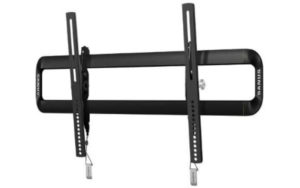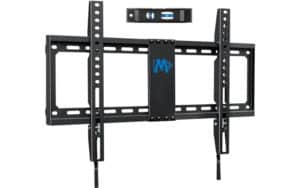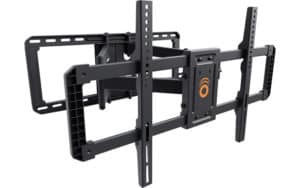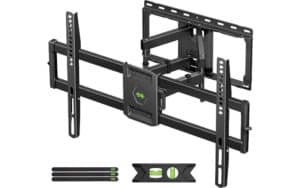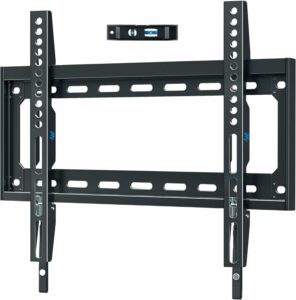Best TV Wall Mounts in 2025 – top mounting brackets for TVs
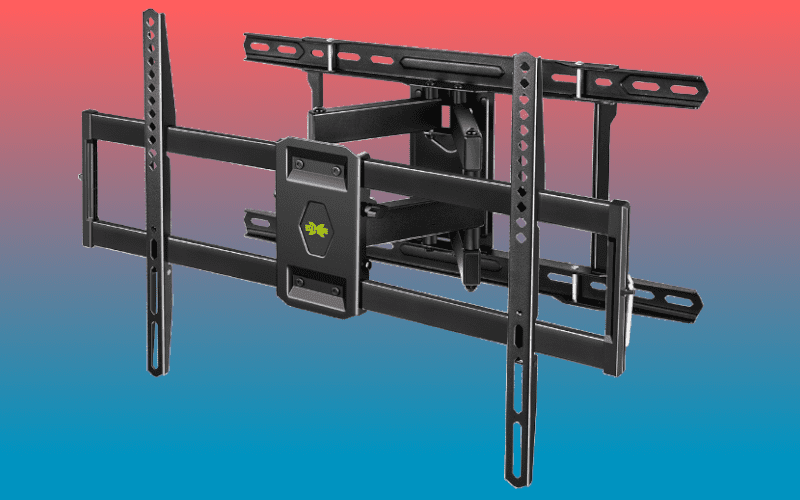
Table of Contents
If you’re looking for the best TV wall mount and brackets, we’ve got you covered right here.
Let’s face it, wall mounting a TV can be slightly daunting, especially if you’ve just shelled out on a brand new TV. Should you wall-mount your TV? What kind of walls do you need to make it secure? What’s all this I hear about “full motion”? Add that to the many, many brands out there seemingly offering the best solution, and you’ve got a challenge on your hands.
That’s where we can help though, and there are a few considerations you’ll want to factor in on your search. Firstly, decide what type of TV wall mount you want. The options are quite simple – fixed or something that moves, be it extending, swiveling, or tilting. Fixed brackets are way cheaper and can give the TV a more low-profile look. TV wall mounts that offer more movement can look less flush against a wall, but they’re great if you want to view it at different positions in your living space.
Practically any TV can be wall-mounted, but be sure to check the compatibility before you go drilling holes in your walls! As for whether you should wall mount your TV or not – we’d say go for it if your TV is on the larger side or you simply want to free up some space in your chosen room.
We’ve selected these TV wall mounts and brackets for a variety of use cases and budgets, so you can cut straight to the chase and get to display your TV in all its glory!
Products at a Glance
How we picked the best TV wall mounts
There’s not really a single wall mount that is better than all the rest. There are different types of wall mount, in different sizes, to fit different rooms and TVs.
With that in mind, we’ve taken a look at the full range and picked some of the best of each type. We’ve broken down what each type is best for, so that you know which one will suit your TV and your setup.
Of course, the one thing that applies to all TV wall mounts is reliability. It’s no good choosing a wall mount that is poorly manufactured, since the last thing you want is your shiny OLED, NEO-QLED or LED TV dropping to the floor due to a malfunction.
So, in all of our research, we’ve made sure to only choose wall mounts that you can trust – provided you follow the guidelines for maximum size and weight. Don’t take these lightly – no pun intended.
Top features and considerations
There are a few key features you need to consider when you’re planning on wall mounting your TV.
Fixed vs Moving
There are three main types of TV wall mount, and which one to buy depends on what you’re looking for from your TV.
Fixed wall mounts don’t move at all. They’re designed to hold your TV in place securely, usually without any angle, so that the screen is flat against the wall. Some of these mounts are super-thin and designed to mount the TV as close to the wall as possible. These are called flush mounts.
Tilting mounts are similar but offer a little bit of movement, letting you tilt the TV downwards so that the top edge is slightly away from the wall. These brackets are best for mounting a TV in a central location high on the wall since you can tilt the screen down so that it’s facing you with you sat on the couch.
The third type of mount is called full-motion. These mounts use arms to allow you to move the TV away from the wall in various directions – you can tilt and swivel. They’re great if you’re mounting the TV in a corner of the room since you don’t have to have it flush against the wall and can instead angle it to face the widest angle.
Some full-motion mounts also allow you to slide the TV up and down. So you don’t need to worry as much about placing the mount at the exact right height.
One other consideration when choosing your mount type is cable access. If you intend to leave the cables as they are, then there’s no real worry. But if you think you may need to disconnect any cables from your TV (say you want the flexibility to move your Nintendo Switch dock from room-to-room) then a full-motion mount makes it much easier to access the ports than a tilting or fixed option.
Size (of mount and TV)
Next up, you need to make sure you get a mount that’ll fit your TV. Which means you’re looking for VESA sizes. VESA is the measurement between the four mounting holes on the back of your TV, measured horizontally by vertically. Mounts will fit different sizes of TV, you don’t need an exact match. But you do need to make sure your TV falls within the range that the mount covers.
Also bear in mind the actual physical size of the mount. You don’t want something huge if you’re only installing a 32” TV, especially if it’s in a tight space. You may prefer to look out for something a bit smaller.
Max weight
Weight is the other really important thing you need to factor in. Some TVs just weigh more than others, depending on the size of the screen and the way it’s been manufactured. It is vital that you don’t exceed the maximum recommended weight for a wall mount. Otherwise you risk the TV falling off and breaking on the floor. You can usually find your TV’s weight in the product manual, or in a product specification online.
Wall to TV distance
One final thing to look out for is the wall-to-TV distance, which tells you the range of measurements for how far the TV can be moved from the wall. Mostly, this is important if you want your TV to sit flush to the wall, as you’ll want the minimum distance possible. But you may also want to check the maximum distance, in case you need to keep accessing cables without any difficulty.
Product Reviews
- Easy to install
- Adjustable side-to-side
- Won’t suit smaller TVs
If you want a simple, effective tilting mount then this Sanus option is ideal. It can handle almost every screen size and pretty hefty weight, with plenty of flexibility in VESA sizes too. Basically, if you own a TV between 42 and 90 inches, it’s almost certain to be safe to use with this mount.
It has tilting angles from 7-12 degrees so you’ll be able to get the perfect view no matter how high you decide to place the mount. Plus, you can slide the TV side-to-side if you need to, which is useful if you have to mount it off-center due to the studs in the wall.
Sure, if you have a smaller TV then you’ll need to look elsewhere. But it’s rare to wall-mount anything below 42 inches anyway so overall it’s a great choice.
- Low-profile mount with 1-inch wall-to-TV distance
- Easy to center with multiple stud spacing options
- Not suitable for large TVs
This wall mount from Mounting Dream is a great choice if you’re trying to get that flush look, perfect with thinner TVs. It can hold significant weight, although it is limited to TVs up to 70-inches just due to the central position of the mount.
It’s also flexible in terms of position, working with studs that are spaced at 16, 18 or 24 inches. This means you don’t have to worry about placing it off-center. And with just a 1-inch distance from the TV to the wall, it’ll look great once it’s in place.
- Wide-ranging motion
- Tilts from 5-15 degrees
- Sits 2.4-inch out from the wall
This excellent full-motion mount from ECHOGEAR gives you a ton of options for how you want to position your screen.
It extends by up to 22-inch and can swivel up to 130 degrees. So it’s perfect for positioning in the corner and having it face the entire room without trouble.
It does mean that when pressed flat the TV will be sat 2.4 inches from the wall. But this isn’t terrible, and you can tilt up to 15 degrees to help hide that.
Installation is easy, being compatible with 16-24” distanced studs or in concrete. And you get up to 3 degrees of leveling once installed too, so it doesn’t have to be perfect first time.
- Great value
- High weight capacity
- Limited screen sizes
- Movement more limited than ECHOGEAR option
Not got a huge budget but want a reliable full-motion mount? This USX option suits most TV sizes (and can easily handle the heaviest screens), with plenty of options for tilt and swivel.
The range isn’t as good as the ECHOGEAR, as it can only extend by 16.5 inches and has a maximum swivel of 45 degrees. But it’s still good enough for most rooms, and at a lower cost too.
Installation is easy although, as a smaller mount, the max limit for stud distancing is 16-inch. If your studs are further apart, you’ll need a larger mount.
- Fantastic low price
- Solid and reliable
- Not ideal for TVs with poor viewing angles
If you’re looking for a fixed TV wall mount and one that’s excellent value for money, we’d recommend going for this Mounting Dream TV mount.
This fixed TV mount is designed to fit most 26-55-inch TVs up to 100 lbs. It’s designed to be low-profile, which means that if you pair it with one of the best OLED TVs (which are known for their super thin screens) it should give the appearance of a flush fitting.
There’s not a whole lot to say about this mount, and that’s a testament to just how straightforward and simple a solution it is. We’d recommend going for this if you don’t need to angle and position your TV in different ways and have a TV that’s more on the small side. Better yet, pair it with one of our top picks for the best 55-inch TVs for a simple, cheap, and easy way of elevating your living space.
Things to consider
Is it better to wall mount a TV or put it on a stand?
In most cases, it’s better to wall mount a TV rather than put it on a stand, providing you have the space and the room layout to be able to.
Using a stand takes up a lot more room, especially if you have a larger TV. But it’s more of a project, especially if you want to properly cable manage it and you’ve got a lot of devices connected to the TV. So, it’s not right for everyone.
How far from the floor should a wall-mounted TV be?
The optimal distance from the floor to the TV will vary depending on the size of your screen. Larger screens should be slightly higher.
As a rough guide, it’s recommended that the center of the TV should be around 56 inches from the floor if it’s a 43-inch TV. Or around 65 inches for a 65-inch TV. But it also depends on how far back you’re able to sit. If your room is narrow then you may want a larger screen to be a little lower.
Can you install a TV above a fireplace?
Generally, it’s not advised to install a TV directly above a working fireplace. The heat from the fire can damage the TV, even if it seems like it’s a good couple of feet further up.
Some TVs may be protected from heat, but this varies by manufacturer and model. Installing a TV above a non-working fireplace shouldn’t be an issue.
Does every TV need to be wall-mounted?
Honestly – not really, and it may not be an option if you’re renting or don’t have the right walls to support the TV itself. We’d say that if your TV is under 60 inches, you can get away with having it on a table, but if it’s above we’d highly recommend wall-mounting. If you’re shopping around for TVs and exploring different sizes, we’ve listed a number of our guides below that can help you find the best option for you.
What type of TV wall mount is best?
When it comes to the question of which type of TV wall mount is best, it depends on your needs. Fixed brackets are fine if you’re planning on keeping the set-up of your TV and where you watch it from pretty stationary, but you might want a tilting or full motion mount if you move around a lot.
Are expensive TV wall mounts worth it?
Usually the more expensive TV wall mounts have the option for flexibility and can be adjusted once on the wall. This means they are worth the extra money if you are planning on changing your home entertainment system set up around once in a while.
Disadvantages of TV wall mounts?
Many wall mounts leave very little space between the TV and wall. Before mounting this should be considered as there may be trouble connecting to the ports, or special cables might be required.
Our Verdict
There’s no single ‘best TV wall mount’ with so many options available. It depends on whether you’re looking for a fixed, tilting or full-motion option. It also depends on your own tastes and your room.
But we’ve picked a great option for each, along with a couple of budget choices too.
We’ve selected the Sanus Premium Tilting as our ‘Best TV Wall Mount’ here. But honestly, any of these featured wall mounts will do a great job. Just make sure you either follow the installation instructions carefully or you get professional help if you’re not confident.
And one final point. Some of the very top-end TVs come with their own wall mounts. For those, it’s recommended that you stick with what comes in the box, since they’re specifically designed for the TV, rather than buying a new one for the sake of it.


